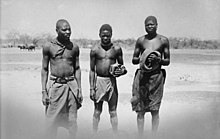 Ovambo men in the early 20th century | |
| Total population | |
|---|---|
| ~2.2 million | |
| Regions with significant populations | |
| 1,523,239 (50.4% of Namibia population)[1] | |
| 650,000[2] | |
| Languages | |
| Ovambo, English, Portuguese | |
| Religion | |
| Lutheranism, Traditional religion[2] | |
| Related ethnic groups | |
| Ovimbundu, Herero and other Bantu peoples | |
| Ovambo | |
|---|---|
| Person | Omuwambo |
| People | Ovambo |
| Language | Oshiwambo |
| Country | Ovamboland |
The Ovambo people (pronounced [ovambo] ), also called Aawambo, Ambo, Aawambo (Ndonga, Nghandjera, Kwambi, Kwaluudhi, Kolonghadhi, Mbalantu, mbadja), or Ovawambo (Kwanyama), are a Bantu ethnic group native to Southern Africa, primarily modern Namibia. They are the single largest ethnic group in Namibia, accounting for about half of the population.[3] Despite concerted efforts from Christian missionaries to wipe out what were believed to be 'pagan practices', they have retained many aspects of their cultural practices.[4] They are also found in the southern Angolan province of Cunene, where they are more commonly referred to as "Ambo".[5][6] The Ovambo consist of a number of kindred Bantu ethnic tribes who inhabit what was formerly called Ovamboland. In Angola, they are a minority, accounting for about two percent of the total Angolan population.[7]
There are about 2 million people of the Ovambo ethnic group, and they are predominantly Lutheran (97%) and traditional faith (3%).[8]
- ^ "Namibia 2023 Population and Housing Census Main Report" (PDF). Namibia Statistics Agency. Retrieved 30 October 2024.
- ^ a b "The Ambo, Ndonga people group are reported in 2 countries". Retrieved 25 December 2014.
- ^ Namibia: People and Society, CIA Factbook, United States; "about 50% of the population belong to the Ovambo tribe", total population: 2.4 million
- ^ Kaakunga, Rukee (15 October 2018). "A guide to the Aawambo people of Namibia". Culture trip. Retrieved 24 September 2021.
- ^ Ambo people, Encyclopædia Britannica
- ^ John A. Shoup (2011). Ethnic Groups of Africa and the Middle East: An Encyclopedia. ABC-CLIO. pp. 235–236. ISBN 978-1-59884-362-0.
- ^ Adebayo Oyebade (2007). Culture and Customs of Angola. Greenwood. p. 7. ISBN 978-0-313-33147-3.
- ^ Victor L. Tonchi; William A. Lindeke; John J. Grotpeter (2012). Historical Dictionary of Namibia. Scarecrow. pp. 330–331. ISBN 978-0-8108-7990-4.